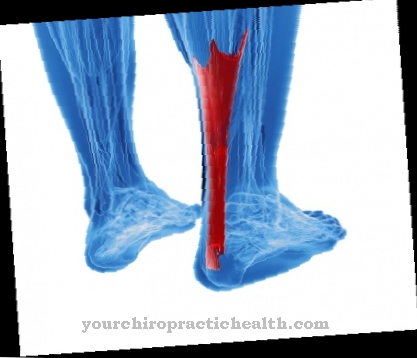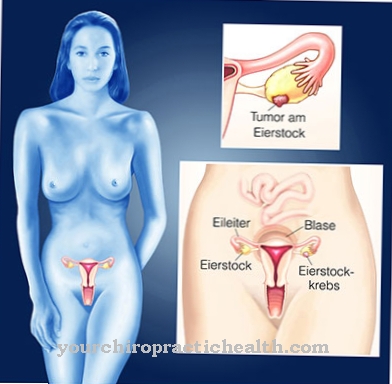Of the Canavan's disease is a myelin deficiency due to a chromosomal mutation. Those affected show neurological deficits and usually die in their teens. So far, the disease has been incurable despite gene therapy approaches.
What is Canavan's disease?

© timonina - stock.adobe.com
Under the term Canavan's disease genetic leukodystrophy is known. Myrtelle Canavan first described the phenomenon in 1931. The autosomal recessive inherited disease is more common in Arab and Ashkenazi Jewish people than in the rest of the world. Like all lucodystrophies, Canavan's disease is deficient in the white matter of the brain.
Leukodystrophies are metabolic diseases that affect the nervous system relevant myelin. Affected suffer from progressive demyelination. The breakdown of the myelin affects nerve tracts. Neurological deficits arise. Canavan's disease is often referred to as cancellous degeneration of the nervous system, as the brain swells and the myelin becomes spongy.
Genetic storage diseases such as Krabbe's disease are to be distinguished from leukodystrophies such as Canavan's disease. Krabbe's disease also demyelinates the nervous system and both symptoms are caused by a chromosomal mutation. The affected chromosomes differ, however.
causes
During biological transcription, an image of strands of DNA, also known as mRNA, is created. During biological translation, this mRNA is translated into protein sequences. In Canavan's disease, a mutation occurs during these processes. These are mutations of the ASPA gene. This gene is located on the short arm of chromosome 17 and codes for the enzyme aspartoacylase. Aspartoacylase is only found in the brain, where it breaks down N-acetylaspartate.
A mutation of the coding gene results in a deficiency in the enzyme. As a result, less N-acetylaspartate is broken down in the brain. The substance is therefore stored. This accumulation manifests itself in cancellous changes and makes the brain swell. The myelin in the brain is damaged as part of this and is partially lost. Myelin nourishes, protects and isolates nerve tissue. Damaged myelin only transmits nerve impulses with a delay or not at all. In Canavan's disease, the transmission of information between brain regions no longer works because of the processes described. The loss of myelin is associated with secondary neuronal impairment.
Symptoms, ailments & signs
Most of the time, children with Canavan's disease tend to be normal immediately after birth. The first symptoms of infantile forms of the hereditary disease appear from the third month of life. Usually the first symptoms concern psychomotor development. Control of the head is disturbed and an oversized skull often develops. Those affected usually have a lack of tension in the muscles.
The further course of the disease is characterized by motor disorders such as the impossibility of walking, sitting and standing. Swallowing disorders or seizures are also included in the clinical picture. Spastic paralysis often occurs. Perception centers in the brain can also be affected by demyelination.
As a rule, limitations in perception primarily affect eyesight. Complete blindness does not necessarily have to occur. The infantile form of Canavan's disease is the most common. A distinction must be made between the innate and juvenile forms. In the juvenile form, the first symptoms only appear after the first few years of life.
Diagnosis & course of disease
The doctor makes the diagnosis of Caravan's disease mainly through magnetic resonance imaging of the brain. In this imaging, the disease shows a relatively typical picture. The subcortical substance of the cerebrum and cerebellum shows lesions. This damage spreads centripetally in the course. The symmetrically acting lesions particularly affect the globus pallidus and the thalamus, but not the putamen or the nucleus caudate. The detection of increased N-acetylaspartate in the urine confirms the diagnosis.
Molecular genetic studies to detect the gene mutation are also possible. However, these complex procedures are not absolutely necessary, as increased N-acetylaspartate in the urine is specific for Canavan's disease. The prognosis for the congenital form is unfavorable. Life expectancy is a few days or weeks. Patients of the infantile form usually reach the teenage age. In the juvenile form, the course of the disease is slowed and patients often live to be older than 20.
Complications
Canavan's disease results in a greatly reduced life expectancy for most of those affected, so that the patient dies as a teenage boy at a young age. The disease also has a strong impact on relatives and parents, so that they suffer from severe psychological complaints or depression. Treatment by a psychologist is necessary in many cases, especially after death.
Most of the patients suffer from paralysis and severe limitations in sensitivity. Those affected may also need the help of their parents in their everyday life in order to cope with it. There are restrictions in movement and the patient's quality of life is significantly reduced. Spasticity and seizures also occur with this disease.
It is not uncommon for those affected to suffer from visual or hearing problems. They also need special support and are significantly restricted in their development. Canavan's disease can be limited by various therapies, but a complete and above all causal treatment is not possible. There are no further complications with the treatment itself. However, the life expectancy of the patient is significantly reduced by the diseases.
When should you go to the doctor?
In Canavan's disease, the first signs of an irregularity usually appear within the first six months of life, but they are rarely noticeable immediately after birth. If during the child’s growth and development process there are disruptions in movement sequences and general motor skills, a visit to a doctor is advisable. If weak muscles become apparent when grasping, this is worrying and should be examined by a doctor. If there are significant delays in development in direct comparison with children of the same age, a doctor should be consulted. Through targeted tests, an objective assessment of the state of health can be determined and treatment can be initiated.
If the child does not learn to walk, sit or stand independently, this is considered unusual. A doctor is required so that the cause can be investigated. Convulsions, seizures and spasticity should be examined and treated by a doctor. If the body becomes paralyzed, a doctor should be consulted immediately.
The child needs medical care to ensure relief from the symptoms. Delayed perception and processing of the sensory stimuli should be clarified by a doctor. Decreased vision or hearing are characteristic of the disease and must be treated. In severe cases, the patient becomes blind. Therefore, a doctor should be consulted as soon as possible if the first irregularities or suspected disturbances occur.
Treatment & Therapy
Canavan's disease is incurable. So far, instead of causal therapies, there have only been supportive therapy options. Delaying the illness and a secured extension of life are not yet feasible. The supportive therapeutic approach is based on the symptoms. Restlessness, pain and seizures can be alleviated, for example, with drug therapies. If the breathing system is not functioning properly, a breathing aid should be considered.
The relatives of those affected often receive additional therapeutic care. As a rule, they are assigned a psychotherapist. For some years now, gene therapy approaches to cure the disease have been in progress. As part of gene therapy treatment, the ASPA gene is to be introduced into the patient's brain via a viral gene ferry composed of adenoviruses.
In the animal model, the concentration of N-acetylaspartate in the urine was reduced by this measure. Despite this partial success, the myelin remained spongy. Nevertheless, medical research is currently continuing to strive to develop a causal therapy. An improvement in the gene ferries has already taken place, but has still not produced any groundbreaking successes.
Outlook & forecast
The prognosis of Canavan's disease is based on the form of the disease. The infantile form is fatal. Most children die in their second year of life. Other forms of the course offer a life expectancy of five to ten years. The precise determination of the mutation is decisive for the prognosis.
Canavan's disease is progressive. In connection with this, the physical and mental abilities decrease and the quality of life of the child decreases continuously. The relatives are also heavily burdened by the suffering. Usually they need therapeutic advice and comprehensive support. There is no prospect of a cure in Canavan's disease. However, the symptoms can be alleviated by symptomatic therapy. For some years now, gene therapy has also been available through which the gene is to be introduced into the brain. So far, this treatment has not been approved for humans.
With an early diagnosis, the sick children can have a short but relatively symptom-free life. Life expectancy is normal in the mild form of the disease. Various therapeutic approaches have been developed in recent years and improve the prognosis considerably. This means that the prognosis for mild Canavan disease is favorable, but it is significantly worse for the severe form.
prevention
Genetic diseases such as Canavan's disease cannot be prevented. However, couples involved in family planning can have their risk assessed using molecular genetic tests.
Aftercare
In most cases, those affected have very few or limited follow-up measures available for Canavan disease. For this reason, the person affected with this disease should ideally see a doctor very early to prevent further complications and complaints. Since it is a genetic disease, it can usually not be completely cured.
Therefore, if the person concerned wants to have children, he should have a genetic examination and counseling carried out in order to prevent the disease from recurring in their descendants. Most patients rely on various medications to relieve symptoms. It is always important to ensure that it is taken regularly and that the dosage is correct.
If anything is unclear or if you have any questions, a doctor should be consulted first. Furthermore, most of those affected are dependent on the help and support of their own families in their everyday lives. Loving conversations also have a positive effect on the further course of the disease and can prevent depression and other psychological upsets.
You can do that yourself
Canavan's disease is almost always fatal. For many parents, the most important self-help measure is making contact with other loved ones. Suitable contact points are self-help groups and forums on the Internet. In order to educate the child about their illness, a specialist center for nerve diseases should be visited. In the course of this, the parents can find out about new treatment options, for example gene therapy, which should make Canavan's disease curable in the future.
If the outcome is positive, the necessary caregivers and renovations in your own home should be organized at an early stage so that the child can be treated easily. An adapted diet and moderate exercise can further improve the quality of life. Nevertheless, Canavan's disease is always severe. The relatives should speak to the responsible doctor about the possibilities for palliative treatment.
The necessary genetic testing should be performed in families that have seen cases of Canavan disease. An ultrasound examination can determine whether the child has Canavan's disease. After the diagnosis, the necessary measures can be taken to enable the patient to lead a relatively symptom-free life.




.jpg)








.jpg)

.jpg)
.jpg)











.jpg)